15 Spanish Egg Dishes You Need To Try At Least Once
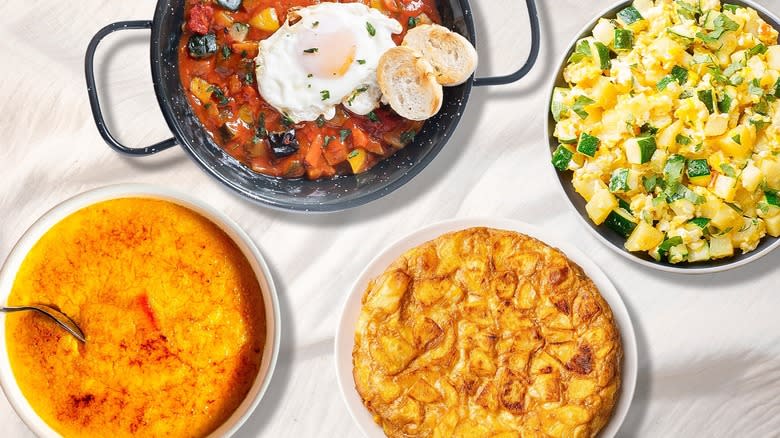
Spain is a country renowned for its rich and diverse cuisine, and there's an endless array of vibrant, flavorful Spanish dishes on our must-try list. From succulent seafood dishes, to colorful tapas plates, and smoky soups, traditional Spanish cooking is incredibly versatile, with a whole host of flavors and textures to explore.
Among the many treasures of the Spanish food scene, eggs are a staple ingredient. We often see them incorporated into traditional dishes, and frequently as the star of the whole recipe. Simple yet versatile, eggs are put to use in many forms. If you haven't sampled the hearty, savory goodness of a tortilla de patatas, the moreish simplicity of huevos rotos, or the indulgent sweetness of crema catalana, then it's time to give them a try.
And if you've never heard of any of these, don't panic. We're here to guide you through our hand-picked selection of the ultimate mouth-watering creations, and why you should add them to your list of must-try foods. They all have origins in Spain, and all feature the humble egg, so get ready to be inspired as you join us in exploring the very best of Spain's delicious and diverse egg-based dishes.
Read more: Ingredients To Take Your Scrambled Eggs To The Next Level
Huevos A La Española
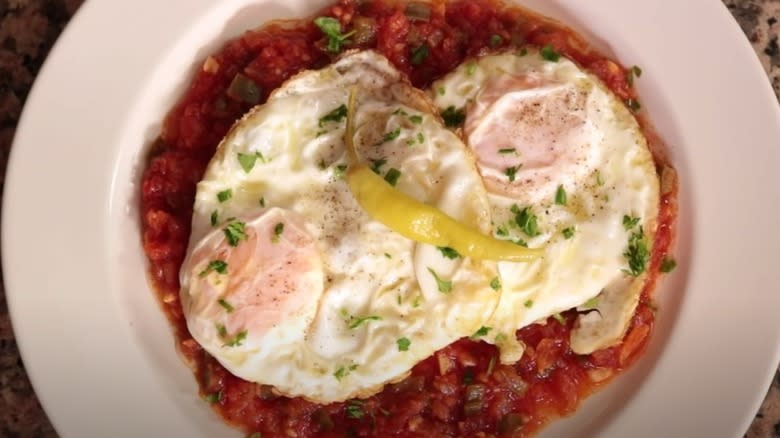
Huevos a la Española, translating quite literally to Spanish-style eggs, is one of the most classic dishes from Spain, and the epitome of rustic, home-cooked comfort food. This hearty dish typically consists of perfectly fried eggs sitting atop a veggie-packed tomato sauce. It's satisfying, delicious, and amazing served with some fresh, crusty bread.
This dish keeps things simple, featuring readily available yet super flavorful ingredients, and coming together in less than 30 minutes. Traditional recipes often include tomatoes, bell peppers, onions, and garlic, all sautéed in olive oil until they are tender and aromatic. The eggs are also fried in a generous amount of olive oil, for even more flavor and giving the whites that lovely crisp texture.
As well suited for weekend brunching as it is for a quick weeknight dinner, huevos a la Española makes a versatile, easy to prep, and flavor-packed meal. For an even more authentic experience, the finished dish can be topped with some tangy traditional Spanish green peppers, called guindilla.
Huevos Rotos

Another traditional Spanish dish that features perfectly fried eggs is huevos rotos, also known as broken eggs. This beloved creation is another fantastic example of Spain's knack for turning simple ingredients into something that's bursting with flavor. It's an indulgent creation that certainly brings the comfort factor, consisting of fried potatoes, onion, and chopped cured meat. This is then topped with the fried eggs -- sunny-side up of course.
When it comes to prep, the potatoes are usually thinly sliced into rounds or batons (think french fry shape), and the onion roughly diced. These are both fried separately in olive oil until tender. A variety of different traditional cured meats would work well in this dish, such as chorizo, serrano ham, or chistorra sausage. If any of these meats are used, they're diced up and fried separately. If ham is chosen, it is sliced it into smaller chunks. There's no need to cook it first.
The bowls are assembled by first adding a layer of fried potatoes, then the fried onions and meat are sprinkled over, and topped with fried eggs. Before they're served, the egg yolks are broken so that the glorious golden goodness spills over everything in the bowl (this is how the dish gets its name!).
Tortilla De Patatas
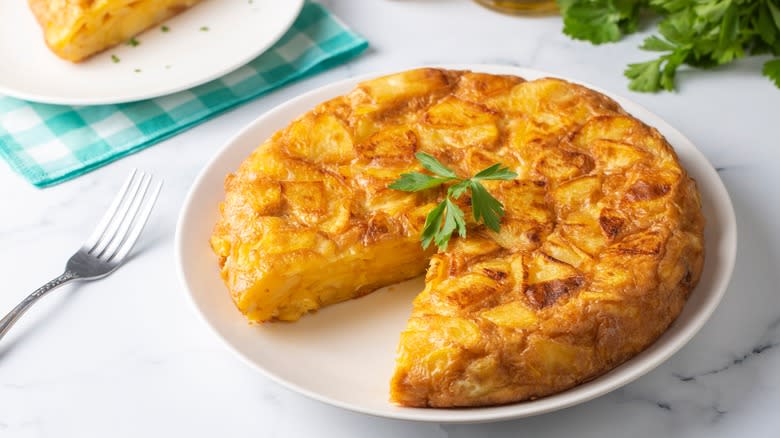
Here's one that may well already be on your radar, but we couldn't leave this iconic dish out of the lineup! Tortilla de patatas (also known as tortilla Española) is one of Spain's most popular concoctions, consisting of the simple yet totally delicious medley of potatoes, eggs, onions, and olive oil.
First, the onion and potato are thinly sliced up, before seasoning with plenty of salt and frying in a generous amount of olive oil (this should be enough to cover everything). Once they're lovely and tender, the potato and onion are drained and set aside. The leftover oil is kept. Now, the eggs are brought into the mix. They're cracked into a bowl and beat well, and seasoned with a pinch of salt. The drained potato and onion mixture is added and everything is tossed together. Some of that reserved oil is heated in a skillet, and the potato, onion, and egg mixture are added. Once the tortilla is cooked on the bottom and around the sides, it is carefully flipped over by turning it out onto a large plate and sliding it back into the skillet. It should then only need another few minutes of cooking on the other side until it is set and ready to serve.
Tortilla Francesa

The tortilla francesa, or French omelette, is a lighter, more delicate alternative to the tortilla de patatas, that truly allows the beauty of simple, well-prepared eggs to shine. Despite its name, this easy dish is a staple in Spanish kitchens, perfect for a quick and tasty breakfast.
This entree consists of minimal ingredients -- just eggs, salt, and some oil, or butter for frying. Some recipes also include a little cream for added richness, but this is optional. The key characteristic of this omelette is its light and airy texture, which is achieved by whipping up the eggs with the salt until they're super fluffy. A fork can be used to make long, fast strokes as whipping takes over to get as much air into the eggs as possible.
Once the eggs are ready to go, the butter or oil is heated in a skillet. The eggs are poured in and stay in until the bottom is set. Now, the tortilla francesa is folded in half, flipped over, and cooked on the other side for another minute or so. It is served immediately with some favorite fresh herbs and other breakfast sides, such as toast and sauteed veggies.
Asturian Tortos With Picadillo And Fried Egg
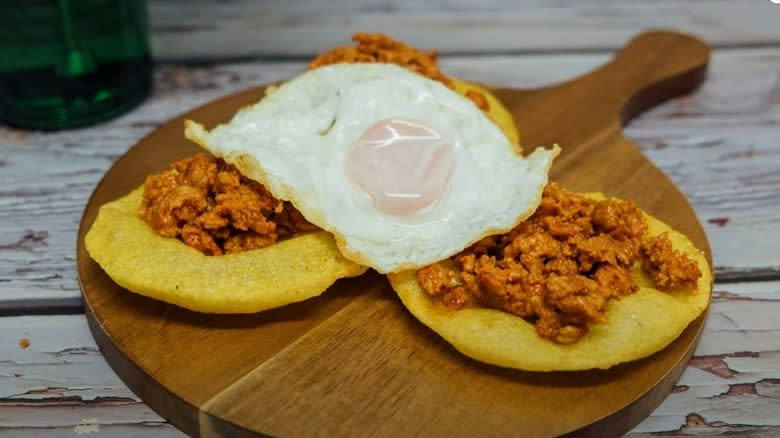
A traditional dish from the Asturias region in Northern Spain, Asturian tortos are savory cornmeal cakes, most typically transformed into a complete meal with the help of fried eggs and picadillo -- a stewed ground meat mixture.
The tortos are made by combining corn flour, wheat flour, water, olive oil, and salt. This is mixed up into a smooth dough, which then needs to rest in the fridge for an hour. Next, the dough is shaped into balls, flattened down into corn cakes with a rolling pin, and fried in plenty of olive oil until crispy and golden.
The picadillo can be made with a variety of different ground meats, such as chorizo, bacon, or ground beef. This is typically fried with spices, garlic, and sometimes tomatoes, or white wine. The freshly made Asturian tortos are topped with the picadillo, then it's time for the crowning glory -- two perfectly fried eggs. The result is a rich, flavorful and satisfying dish where all the tastes and textures work together beautifully.
Huevos A La Flamenca
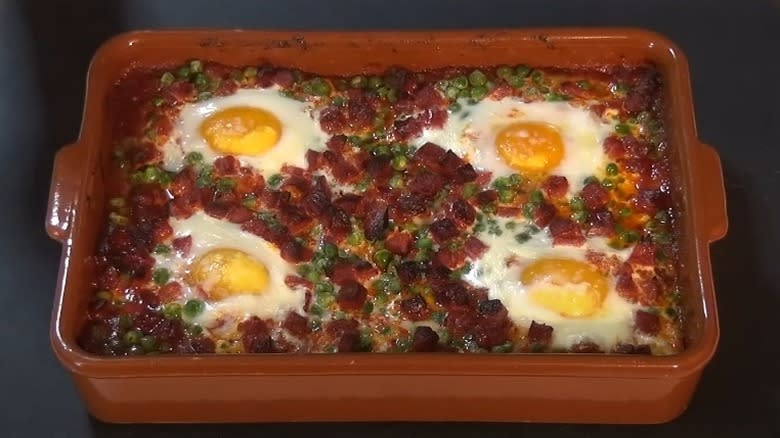
Up next is a vibrant dish consisting of a veggie-loaded base, flavorful cured meats, and golden eggs that are poached right in the sauce. Huevos a la flamenca is a dish from the Andalusia region of Spain, much loved for its rich flavors and colorful presentation.
This creation typically starts with a base of sauteed veggies -- onion, red bell pepper, and tomatoes. Some recipes also incorporate cubed potatoes or cheese. This rich sauce also gets a healthy dose of aromatic garlic and spicy paprika, bringing an extra layer of savory flavor. Then, similar to a shakshuka or huevos rancheros, this next step is familiar. The sauce is transferred to a baking dish, or, if an oven-proof skillet is being used it can be left in there. A spoon is used to create wells in the sauce, then the eggs are cracked right in. After about 10 minutes in the oven, the eggs should be cooked through, nestled amongst that flavorful sauce. Now, everything is topped off with the delicious cured meat. Scatter over crispy fried chorizo and pieces of serrano ham, and you're ready to dig in with some crusty bread.
Zarangollo
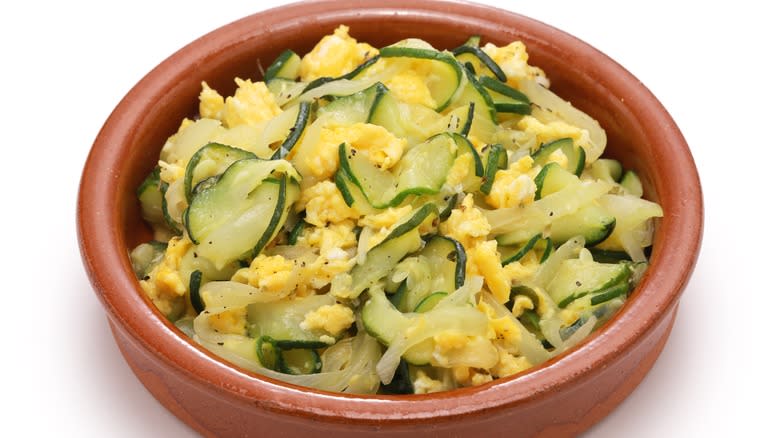
If you love scrambled eggs, zarangollo is one for your must-try list. This traditional egg dish from the Murcia region in southeastern Spain is a unique take on a classic egg scramble, with some added veggie goodness.
Zarangollo consists of just four wholesome ingredients -- eggs, onion, zucchini, and olive oil. First, the eggs are whisked with some salt and pepper, but not to the point where the yolks and whites are completely combined. There should be a few egg white streaks visible. Next, the olive oil is heated in a skillet and sliced zucchini and onion are fried until tender. The eggs are added and mixed frequently until softly scrambled yet still in fairly big chunks. And it's as simple as that!
This creation is great served as a tapas or side, along with rice or potatoes, meats and fish, or a fresh, crisp salad. You could absolutely enjoy zarangollo for breakfast too, perhaps spooned on top of some buttered toast.
Tortilla De Manzana
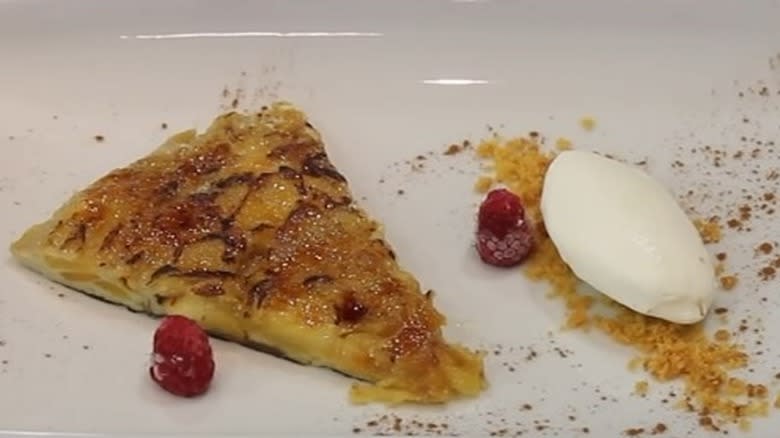
Moving into the desserts realm, we have a classic Spanish sweet treat -- tortilla de manzana. This dish combines apples and eggs to make a comforting, fruity offering that's sure to impress.
The primary ingredients for tortilla de manzana tend to be apples, eggs, sugar, butter, milk, and flour. First, the apples are peeled and sliced, removing the cores. They're then mixed with a splash of lemon juice to prevent them from browning. The apple slices are arranged in a greased baking dish. Next, the flour and brown sugar are mixed and scattered over the apples. Some melted butter is poured in, then whisked together with the eggs and milk, and this is poured over the fruit too. Then, it is simply baked until set and golden.
Tortilla de manzana is delicious served with ice cream, cream, or just a simple dusting of powdered sugar. There are a few different takes on this creation, with some skipping the flour, and others the butter. But eggs and apples always feature as the stars of the recipe here.
Huevos Con Bechamel
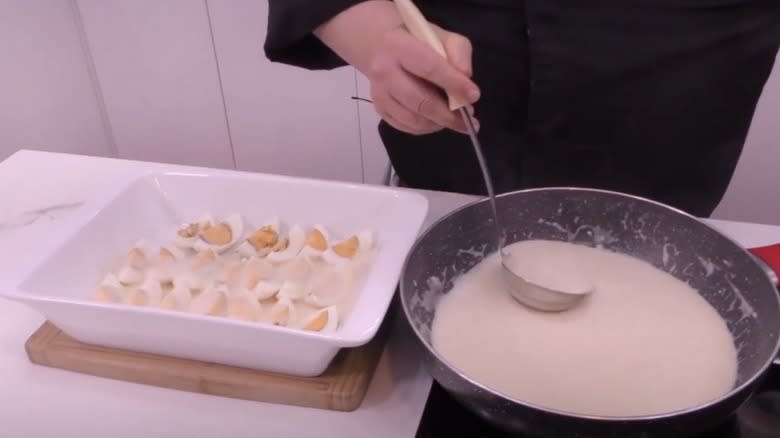
If you're looking for an egg-based dish that oozes indulgence, huevos con bechamel is about to become your new favorite. This decadent creation elevates simple baked eggs with the richness of a creamy bechamel sauce and plenty of cheese.
First, the eggs are hard-boiled, which should take about 10 minutes in a pan of boiling water. Whilst they cool, the bechamel sauce is made. Butter and flour are mixed in a saucepan until we have a roux, then milk is added gradually and whisked until the sauce is thick. It can be seasoned with salt and pepper to taste, and a pinch of nutmeg if desired. Now that the sauce is prepped, the eggs are peeled and sliced into halves or quarters. A small amount of the sauce is poured in the bottom of a baking dish and the egg halves are placed on top. Some fried bacon pieces can also be added for some extra flavor. Then, the rest of that wonderfully creamy sauce is poured over, before being sprinkled with plenty of cheese.
Finally, everything gets baked in the oven, until the cheese is bubbling and browned. Huevos con bechamel can be served fresh out of the oven with a crisp green side salad.
Pisto Con Huevos
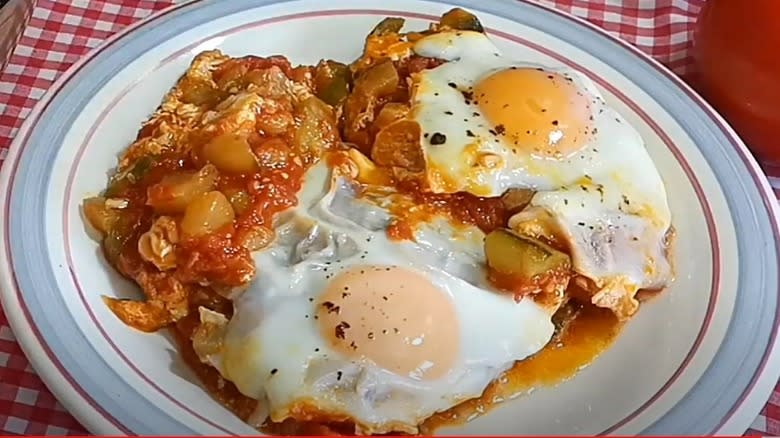
Often referred to as the Spanish ratatouille, pisto con huevos is another delicious traditional dish that features eggs baked into a veggie-based sauce. It's rustic, flavorful, and full of vibrant and nutritious vegetables.
For the base of this dish, onions, peppers, and garlic are sauteed. Then, a mixture of herbs, such as oregano and thyme, are added. Plus, even more veggies -- zucchini, aubergine, and tomatoes. Once everything has cooked down into a rich, hearty stew (the pisto), the eggs are carefully cracked on top. As the pisto bubbles away, the egg whites will cook through, maintaining those wonderfully runny, golden yolks.
Pisto con huevos is best served right away. Add a scattering of fresh parsley and spoon it right from the skillet, as a main course or as part of a larger tapas spread. Crusty bread has to be essential here, for mopping up that rich sauce and runny yolk.
Huevos Rellenos
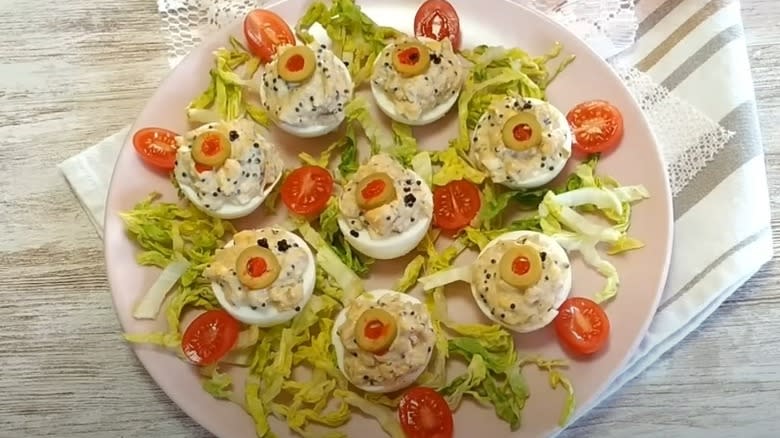
It's time to give the humble deviled egg a Spanish twist! Huevos rellenos is a popular Spanish appetizer, prepared in a similar way to the halved and filled eggs we know and love. This recipe is incredibly versatile, with no set ingredients when it comes to the filling. Instead, there are a range of options for adding authentic Spanish flavor to these bite-sized beauties.
As with deviled eggs, the first step to the dish is hard-boiling the eggs. Once they've cooled, the shells are peeled off, they're sliced into halves, and the yolks are removed from the whites. Then, the yolks are simply mashed up with some mayonnaise and sometimes some add-ins. Popular ingredients include canned tuna, chopped olives, or pickles, or even a combination of avocado, tomato, and cilantro for guacamole-inspired eggs.
Then the filling can be spooned right back into the hollowed-out egg whites, or a piping bag can be used for added finesse. They're garnished with a little paprika or some chopped chives for a vibrant finishing touch.
Migas Con Huevo
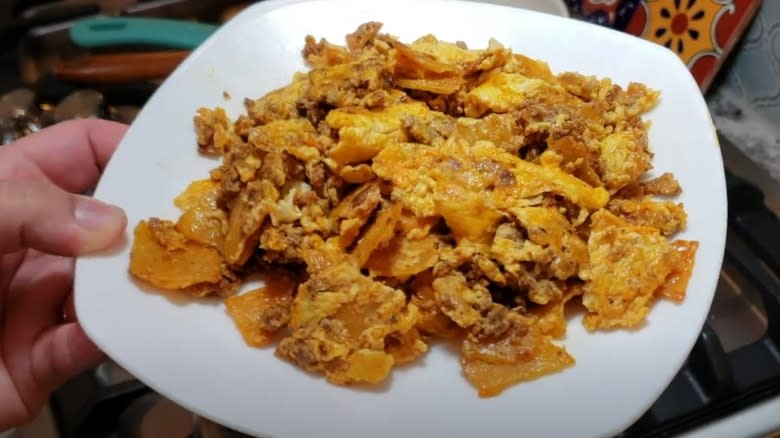
If your egg dishes don't feel complete without a carb element, migas con huevo will definitely satisfy your cravings. It features corn tortillas sliced into strips and mixed up into a scramble with onions, tomatoes, and eggs.
This traditional Spanish recipe was first developed to include stale bread, serving as a handy way to use up leftovers, but it's more commonly made with tortillas today. The dish starts with a base of fried onions, jalapenos, and tomatoes, seasoned with salt, and pepper. Then, the eggs are whisked with some more seasoning, and poured into the pan with the veg. Strips or squares of toasted tortilla are added and everything is slowly stirred together until the eggs are set. There's also the option to add some shredded cheddar cheese, which can be scattered on top of the final dish, or mixed through the eggs before scrambling.
Serve up your migas con huevo with your sides and sauces of choice, such as sliced avocado or a dash of hot sauce. Though we think this one makes a wonderfully satisfying and balanced meal served as is.
Crema Catalana
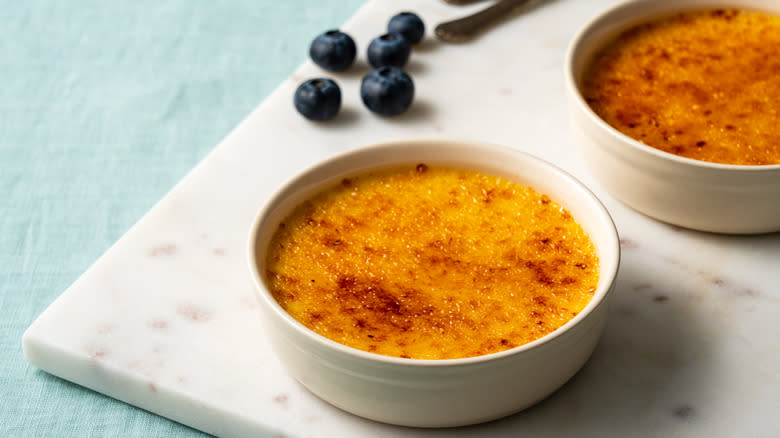
If egg based desserts are more your thing, crema catalana is a wonderfully creamy, custard-like dish that you have to try. Similar to a French crème brûlée, the Spanish version is lighter, and focuses more on citrus flavor and cinnamon rather than vanilla.
Eggs are an essential ingredient in a classic crema catalana, but just the yolks. These bring plenty of richness to the dessert. The yolks are whisked together with some sugar, cornstarch, and salt, and the bowl is set aside. Next up, some milk is brought to a simmer in a saucepan, infused with pieces of orange and lemon zest, as well as a cinnamon stick. Then, the egg mixture can be tempered. The infused milk is gradually poured into the egg mixture, and whisked constantly. Once all of the milk has been combined with the eggs, everything is poured back into the pan and simmered until you have a thick custard.
The crema catalanas are usually portioned into ramekins, and chilled in the fridge to set. For that authentic crunchy top, each one is sprinkled with sugar and caramelized with a blow torch before serving.
Yemas De Santa Teresa

Some lesser known but just as mouth-wateringly tasty sweets from Spain are yemas de Santa Teresa. These round, bite-sized treats are popular in the Avila region, often made in celebration of Saint Teresa's Day in Spain. And, they require just four ingredients.
These unique desserts first require a syrup to be made by combining water and sugar in a saucepan. Once the liquid is boiling and sugar has dissolved, lemon peel is added, and everything bubbles until thickened. As with crema catalana, it's just the egg yolks needed here, so they're whisked up in a separate bowl. The lemon peel is removed from the syrup, then the beaten yolks are poured in and whisked over a low heat until the mixture starts to become very thick.
Once it has cooled, it can be handled like a dough. Then the work surface is dusted with powdered sugar and the dough is placed on top. Small pieces are broken off and then rolled into balls before each one is covered in powdered sugar. The yemas de Santa Teresa go in the fridge to set, where they should form a lovely crisp outer coating.
Tecula Mecula
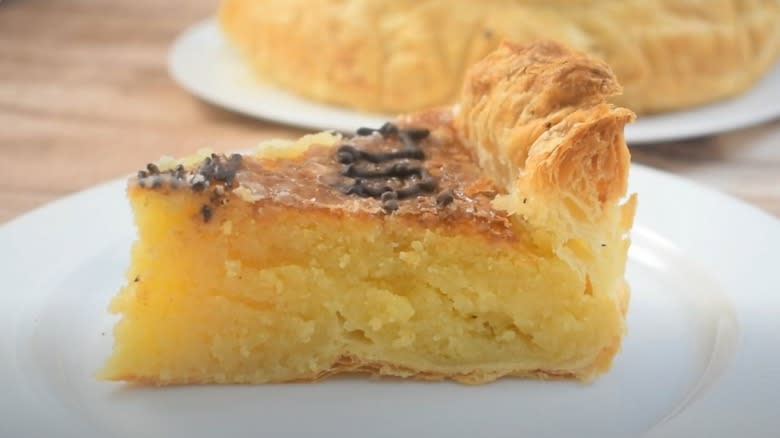
A final Spanish egg-based dessert for those with a sweet tooth -- tecula mecula. This moreish tart dish combines almond and egg, resulting in a rich and indulgent treat with heaps of nutty flavor.
It starts with a simple sweet pastry base, which can be made from scratch or store-bought. For the filling, sugar, water, and lemon zest are added in a saucepan, and stirred over a low heat until the sugar is dissolved. To turn this into a syrup, the mixture is brought to a boil, before returning it to a simmer and leaving it to bubble. Next, butter and almond meal are mixed together, and the egg yolks are separately whisked up. The cooled syrup is poured into the eggs and whisked until fluffy. Then, the almond and butter mixture are added, along with some flour, and mixed to combine.
Finally, the pastry is filled with the egg and almond concoction and baked until set and golden on top. We think this would be amazing served with a dollop of vanilla ice cream!
Read the original article on Mashed.


